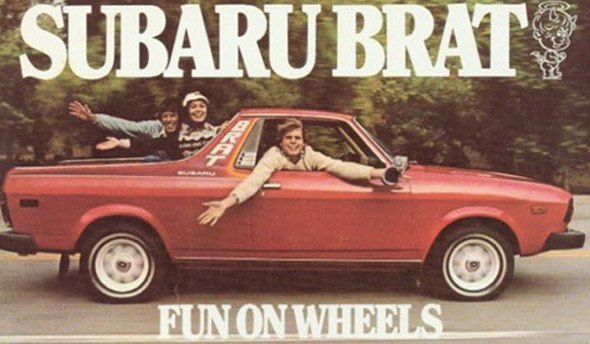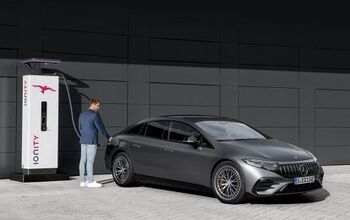The Scrappiest Car Maker Ever? A Brief Illustrated History Of Subaru

That Subaru is still thriving is in itself a minor miracle. The small Japanese car makers have either imploded (Isuzu), are threatening to (Mitsubishi), or have sought shelter (even Subaru is now 20% owned by Toyota). Subaru did have its own near-death experience in the early nineties. But in a long string of wild bets, Subaru’s final card in the US was a big gamble on AWD, and the timing couldn’t have been better. And like most successful gamblers, there have been losses along the way (see above). But perhaps because of the bumpy ride, Subaru is still alive and kicking.
Fuji Heavy Industries was a consolidation of four firms in 1953, and decided to get in the nascent car business. The first car, the 1500 (above) of 1954, was a conventional sedan. But the market for such a relatively large car was very limited, so the next design was for the newly established kei car class, then limited to 360 cc engines. The Subaru 360 became the firm’s main product, but that it would be its first product exported to the US probably surprised themselves as much as anyone. And that it would somehow take off is one of the more unlikely success stories.
The 360 was clearly inspired by the VW Beetle, but it made the Volkswagen look enormous by comparison. A noisy and stinky little 2 cylinder two-stroke engine pushed the the silly little car around, but not in the way Americans were used to. Enter one small-time entrepreneur, Malcolm Bricklin. He had the idea to import the 360, probably(and not surprisingly), it was the only Japanese maker without any export plans to the US. How he sort of pulled it off is a minor miracle, but lets just say that in the land where pet rocks can make you a multi-millionaire, why not create a fad for a totally unsuitable (and unsafe) car. Americans’ gullibility is infinite.
Consumer Reports (rightfully) branded the 360 “The Most Unsafe Car In America”, and sales quickly petered out. But Subaru had a very advanced new car in the wings, which appeared just in time to bail out Bricklin and Subaru of America. He sold it to Subaru a few years later for big bucks, and went on to his many other notorious failures and successes (Bricklin SV-1, Bertone Fiats, Yugo, Chery, etc.).
In an example of how what goes around comes around, here’s a Subaru 100mpg experimental based on the 360 from the early seventies that looks ready for the X Prize contest going on currently.
The Subaru 1000 of 1966 was an extremely advanced design for the times, even by European standards. The ill-fated Lloyd Arabella of 1959 had a similar layout, but was never properly developed and crashed along with Borgward. By conservative Japanese standards, it was a breakthrough; the first mass-produced FWD car. A true clean-sheet approach resulted in what almost every engineer would favor if not constrained by other factors: a very compact boxer four mounted low just ahead of the driven front wheels.
The intrinsic balance of a boxer four make it smooth running (if not always so in its exhaust sound), and its location create an optimal low center of gravity. FWD resulted in an unusually roomy little car, offering better space utilization compared to its competitors, the RWD Corolla and Datsun Cherry.The original 1000 became the Star in 1969, and was imported to the US beginning about that time.
One of the unusual aspects about the 1000 was that it had no heater core, but rather it had two small radiators, one of which was used to like a heater core to heat the interior. And like many early FWD cars, the 1000 used inboard drum brakes at the front to reduce unsprung weight.
How Subaru came to be so heavily associated with 4 wheel drive was, like so many things, an accident, and not the result of market research or focus groups. In 1970, the Tohoku Electric Power Company asked Subaru to build them some four wheel drive versions of the 1000 wagon, to replace their elderly Jeeps. Given the configuration of the Subaru, it lent itself very readily to the conversion (see Subaru GL Wagon CC). One of the original handful of converted wagons has been restored and is on display (above). Little did Subaru know what a pioneering vehicle it had on its hands.
In 1971, the new Leone (DL/GL in US) series replaced the 1000/FF-1/Star. Strictly an evolution, it maintained the 1000’s basic configuration in a larger and more rationalized form: gone were the inboard brakes and weird heater setup. Styling was eccentric, which has been said to be influenced by Nissan, which bought a 20% share of Subaru in 1968. There’s no doubt that the Leone was somewhat similar to the Datsun F-10, and reflects one of the less desirable Japanese styling trends.
There was even a hardtop coupe in the Leone/DL-GL series. But the practical wagons and sedans were the mainstay of the Subaru lineup.
The 4WD wagon was first put in production in 1972, but introduced to the US in 1975. It is a major automotive milestone, as the first mass production popular priced 4WD passenger car. It spawned a revolution of the mass adoption of 4WD and AWD cars and crossovers.
A couple of years later, Subaru launched another innovative vehicle, the BRAT. Obviously influenced by the passenger car-based El Camino and Ranchero, the BRAT was the first of its kind in two significant ways: compact size and 4WD.
In order to get around the US “chicken tax” on imported pickups, Subaru mounted two rear facing seats in the bed to qualify it as a passenger vehicle. Ironic, given the lengths manufacturers have gone to get their cars certified as trucks under the EPA rules. Whether the BRAT was a toy or practical little trucklet depended on its buyers, but it launched a whole category that was rather short lived, with the VW pickup and the Dodge Rampage.
In 1979, a new generation of Subarus was unveiled. As always, wider, larger, and roomier; they moved on from the narrow-body that had tax advantages in Japan. A larger 1.8 engine powered most of the US bound versions, and for 1983, a turbocharged 1.8 with MPFI. Available only with an automatic, it also used Subaru’s firstfull-time all-wheel drive system, a forerunner of the more advanced recent systems. This was a substantial move to position Subaru upmarket, against the growing influx of all-wheel drive cars like the Audi 4000/80 quattro.
In case it wasn’t clear, Subaru expanded available 4WD to all of its models, including the coupe and hatchback. Although FWD Subarus were also being sold, Subaru was clearly leveraging its 4WD capabilities.
Subaru’s new Leone line for 1985 was another significant incremental step away from the Corolla class and into the Camry/Accord class. In the process, the scrappy little Billy Goat image was ever more falling by the wayside, which would come back to bite. A new OHC 1.8 engine powered this family of cars also known as the GL or Loyale in the US.
Subaru also branched out into the sporty coupe sector, with their (inevitably) individualistically designed XT Coupe. Available with four wheel drive or FWD, and a variety of engines including a turbo four and in the last years, the flat H6 engine that would reappear in the SVX. Aerodynamics were an excellent Cd .29.
Unlike most automakers, Subaru always realized the significant role wagons played in its lineup, and showed several concept cars on that theme, including this SRD1 from 1990.
In 1989, Subaru introduced the Legacy, a clear attempt to take the brand a small notch upscale. Its predecessor, the Loyale, was retained as a lower cost alternative. But although Subaru’s now well developed full-time AWD system was of course available, one couldn’t tell by looking. The old Subaru 4WD wagon’s jacked up ride height and tough demeanor was now lost in a soft and genteel low rider that was chasing the Camry and Accord, and rather futilely at that.
Sales trended downward precipitously during this period, and there were questions raised whether Subaru would survive in the most competitive market in the world. The fact that numerous competitors also were offering AWD variants of their cars hurt, and badly.
It was in response to input from Subaru USA that the Outback was created in 1995. The SUV boom was in full bloom, and this was Subaru’s last chance. The Outback jacked up the Legacy and threw some bigger tires and SUVish cladding for one of the most successful makeovers ever. It totally saved Subaru’s bacon in the US.
We’re running out of time and space to give Subaru’s more recent history full justice (including the little Justy, which we’ll cover in a CC soon). The Impreza of 1995 was a significant expansion of Subaru’s line up, but it didn’t really find its full potential until the brilliant WRX and its STI offshoots. Finally, Subaru was able to capitalize on its Rally success with a pocket rocket that put gave serious street cred to the mark of the Pleiades.
With the Forester’s appearance in 1998, Subaru once again had a more compact and tall wagon without the Outback’s affectations to appeal to the Subaru loyalists as well as compete successfully against the cute utes from Honda, Toyota and others. It’s car-like agility and excellent power for the times (essentially the same 2.5 L 170hp boxer still powering today’s Subies) made it a hit that is still going strong with the recent redesign.
Subaru’s only miss in recent years has been the Tribeca, which was too bloated, weak chested and weak kneed to make a mark for itself in the crowded mid-size CUV market.
Whether Subaru can maintain its momentum in the changing demands of the market and EPA regs that disadvantage AWD vehicles remains to be seen. Hybrids are on the way, and if they can properly blend and enhance with Subaru’s other qualities, Subaru may buck the trend and forge ahead. But to assume that that the road ahead for Subaru won’t be bumpy would be unrealistic, AWD or not.

More by Paul Niedermeyer
Latest Car Reviews
Read moreLatest Product Reviews
Read moreRecent Comments
- V8-1 Go hybrid and wait for Toyota to finish its hydrogen engine and generator/separator.
- Poltergeist I expect this will go over about as well as the CR-Z did 15 years ago.
- Michael S6 Welcome redesign from painfully ugly to I may learn to live with this. Too bad that we don't have a front license plate in Michigan.
- Kjhkjlhkjhkljh kljhjkhjklhkjh A prelude is a bad idea. There is already Acura with all the weird sport trims. This will not make back it's R&D money.
- Analoggrotto I don't see a red car here, how blazing stupid are you people?
























































Comments
Join the conversation
Owned one of the first Subaru FF-1 1100 wagons in California when they were introduced here. Liked it so much I bought a 2nd one. They were good little cars, very dependable. No ac option at the time. Easy to service. Replaced the engine with a 1300 cc which made it a perfect combination. Later I owned two Brats which were also a lot of fun and dependable. Put a lot of miles on them. Upgraded one of them to an 1800 cc engine with dual range 4wd out of a later year. Made the Brat an even better vehicle. Was never disappointed by the Subaru's I owned.
Having owned several Subarus starting with a 1981 GL and continuing till current 2018 Outback, I think these cars are great. None of mine ever needed major repairs, although some got major upgrades. And, all made it easily to the 250k mark.